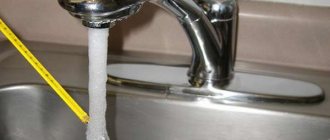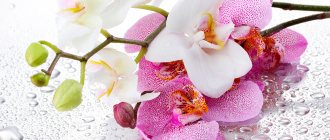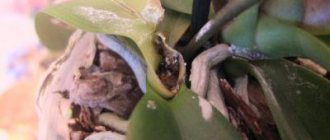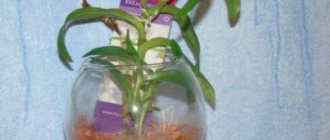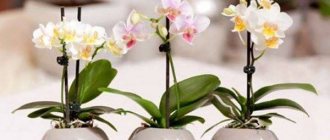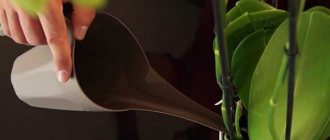Orchids have been occupying a leading position in the ranking of the popularity of indoor plants for several years now. This is the most “giftable” plant. Therefore, an orchid often falls under the care of a person who is very far from floriculture and has very vague ideas about how to grow it correctly. With careful and proper care, an orchid can grow at home and delight us for many years. This care is simple and not burdensome. Minor deviations from the rules of care do not cause significant harm to the plant. But, alas, as sad statistics show, almost half of donated orchids die after the first flowering. The reasons for this are different, but they are all a consequence of ignorance of the rules of care or careless implementation of them. The absolute leader among these violations belongs to improper watering.
When and how often to water orchids
First, let me clarify. Among orchids there is also a clear leader - phalaenopsis. This is what is most often given as a gift. More exotic Miltonias, Cambrias, Dendrobiums, Cymbidiums, Paphiopedilums and others are significantly inferior to Phalaenopsis in terms of “purchasability and giftability”. Therefore, we will consider the rules for watering orchids using his example. First of all, it should be noted that the frequency of watering orchids at home will depend on factors such as air temperature, humidity, substrate composition, pot volume, life cycle and time of year. External primary signs of the need to water orchids are:
- The roots of the plant have become pale green or white. With normal watering they should be green.
- The walls of the pot are dry. If there are even the smallest drops of moisture on them, they should not be watered.
- The orchid pot is very light.
- You can carefully lower a dry stick into the pot and check the humidity in its depths.
- With prolonged drying, orchid leaves wither and turn yellow.
Note! Dry pieces of bark on the surface of the pot are not a reason for the next watering. The frequency of watering also depends on the time of year. Usually, orchids are watered once a week in summer, and in winter, during the dormant period and in preparation for flowering, no more than twice a month.
Signs indicating the need for watering
You can tell that it’s time to water your orchid by the following signs.
- Condition of the substrate in the pot. The easiest way is to visually assess the condition of the filler in a transparent pot. The light color of the substrate and its dryness are a signal that the plant needs watering.
- Lack of moisture in the pot. The orchid should not be additionally moistened as long as there are droplets or streaks of condensation on the walls of the container.
- State of the plant. Limp leaves and light, wrinkled roots clearly indicate a lack of water. Sufficiently moistened orchid roots are bright green. As the roots dry, they lighten and acquire a silver color.
- Weight of the pot. It is useful to hold the container with the plant in your hands after watering. When the substrate dries out, the pot will become much lighter, and this change will indicate the need for watering.
- You can also determine the need for watering using a wooden stick. It must be carefully lowered into the substrate so as not to damage the roots. If the stick is wet, the orchid is still sufficiently hydrated.
Water for watering orchids
For regular watering, you cannot use water taken directly from the tap. At a minimum, it should be defended. But this is not enough. Ideally, water for watering an orchid should be boiled or passed through a filter. The presence of salts, iron and chlorine compounds in its composition is extremely undesirable. You can soften the water and make it more suitable for irrigation using peat. To do this, you need to take a handful of high-moor (sour) peat, wrap it in a napkin and put it in a container of water (about 3 liters) for 10-12 hours. Oxalic acid is also used to soften water. Note! Water for watering orchids must be warm.
What orchids are grown in water?
Not all varieties of orchids are suitable for growing indoor flowers in water. Flower growers note that phalaenopsis and other domesticated species grow well in these conditions. Choose those that do not have a resting phase with drying of the roots:
- Phragmipedium.
- Dendrobium. It is best to place a container with water and an orchid in a cool room.
- Cattleya with flowers 20 cm in diameter. It develops better in a warm environment, but does not like heat.
- Mormodes, whose petals and sepals are predominantly dotted with spots, dots and strokes.
- Zygopetalum with fragrant bicolor and tricolor petals.
Watering orchids at home - methods
Dive
The most effective and common method. If possible, purchase a special container for watering orchids that matches the size of your plant's pot. In fact, this is the same pot, but without drainage holes. When using it, you will avoid floating and overturning the pot with the plant. In the absence of such a container, you can use any other container of a suitable size. The pot with the orchid is lowered into it so that the water level is one centimeter below the top edge of the pot. Usually 10-15 minutes are enough for the substrate to become saturated with moisture. A sign of this will be the appearance of moisture on its upper layer. After this, the pot must be removed from the water and all moisture allowed to drain. During such watering, you can also feed the orchids by dissolving fertilizer in the water.
Top watering (using a watering can)
This method is also used. But you should be careful when using it. Do not allow water to get into the axils of the leaves. Its accumulation can cause rotting of the orchid leaf. For watering, it is better to use a watering can with a long thin spout. Watering is carried out in several stages. Water flows until it begins to flow through the drainage holes. Then a break for a couple of minutes, and the procedure is repeated. And so 3-4 times. Drain the water that has flowed into the pan.
Watering with running water (warm shower)
This is the case when watering from the tap is allowed. But only if this method is not permanent, but is used only occasionally. Otherwise, use a garden watering can. This method of watering orchids is closest to natural, as it imitates rain. In addition to moistening the substrate and the roots of the plant, dust, possible pests and other nasties are washed off from the leaves. It also stimulates foliage growth. Watering is best done in a bathtub, but you can put a pot with a plant in a basin if you water it with a watering can. Water for irrigation should be warm, sometimes even hot water of 40-50 degrees is used. Watering the orchid continues until the substrate is saturated with moisture. After this, the water from the pot is allowed to drain and the orchid is left in a shaded place for 30-40 minutes. Then you should definitely wipe the leaves with a dry cloth, but the main thing is to remove all moisture from the axils of the leaves.
Spraying the roots
This method is unlikely to be useful to novice gardeners. It is used for orchids that are grown openly, without the use of a substrate. In this case, a spray bottle with a very fine spray of water is used. With its help, the roots of the orchid, fixed to the supporting surface, are abundantly irrigated.
Watering at different periods of the growing season of orchids
A number of factors should be taken into account when choosing a watering regime in different seasons:
- air humidity;
- duration of daylight hours and illumination of the place;
- the size of the pot and the composition of the substrate;
- phases of the growing season of the flower itself.
During flowering
The flowering period of orchids usually occurs in the summer months. During this time, water it every 2-3 days. Keep in mind that water should not get on the flowers themselves. During this period, the plant should not take a “shower”.
How to water a flower in autumn and winter
After the flowering period in autumn, one watering per week is sufficient.
In winter there is a dormant period, so reduce watering to once every 10–14 days. The substrate should not be allowed to dry out excessively. The main thing after watering is to let the water drain, otherwise the wet roots will get too cold on the windowsill.
Features of care after transplantation
In the spring, the orchid is replanted, the substrate is changed, so it experiences stress. The new substrate should be saturated with moisture by immersion, the water should be allowed to drain well, and the plant should be placed in a shaded place.
The plant is not watered for half a month, because excess moisture aggravates stress. In the future, it is enough to moisturize moderately, once every 7 days.
Watering orchids after purchase
This point deserves special attention. The fact is that in most cases, phalaenopsis, which are sold in flower shops, have a specific soil composition. In addition to the obligatory bark and sphagnum moss, they may contain anything that helps give and maintain the plant’s marketable appearance. We understand that the main thing for a merchant is to sell, and what happens next is our headache. Most often, in the composition of the substrate you can find some kind of moisture accumulators, called among gardeners “sponges”, “washcloths”, “sponges”, which, in fact, are what they are. These are pieces of synthetic material that absorbs a large amount of water and allows you not to water the orchid for a long time, which is important during transportation and mass storage. There's nothing particularly scary about this. The material is synthetic, therefore, does not rot or decompose. But its danger lies in the fact that the watering schedule in this case changes radically. It is very difficult to determine the absence or presence of moisture in such a “battery”. And their very presence may raise doubts. Conscientious sellers always warn that the substrate contains a sponge. Otherwise, it may turn out to be an unpleasant surprise. Experienced gardeners, after purchasing any plants and after two weeks of quarantine, replant them in fresh soil. But not every amateur can do this, and it is not advisable to do this during flowering. Therefore, when purchasing, be sure to ask the seller about the presence of such surprises. And if they are, then all watering before replanting the orchid should be carried out less than once and a half to two times. In any case, after purchasing, place the orchid separately from other plants (if any) and quarantine for 7-10 days. There is no need to water at this time. Then you can start watering. I recommend doing the first watering with boiled or distilled water. It is better to use the immersion method. And repeat it several times, changing the water. This will wash away unnecessary salts from the soil. Of course, the fertilizers with which manufacturers and sellers fertilized them will also go away. But you don't need them. Usually, these are very strong stimulants that deplete the plant. It is better to buy high-quality fertilizer and use it.
That's all the basic rules for watering orchids. But, there will also be a considerable number of nuances that will be specific to your plant, and here everything will depend on you. Try different methods and decide which one is best for you and your plant. Observe the plant and substrate. It won't be long before you can accurately determine when and how to water your orchids.
How to water orchids - video
There is a special method for growing orchids in water. To do this, you need to have a glass vase with transparent walls and the necessary knowledge for cultivating the plant using hydroponics.
Next, we will tell you whether and how long it is possible to keep an orchid in water for the benefit of the plant.
Useful video
Watch a video about watering an orchid in a pot:
Hello dear readers of Bediva.ru. With this publication we begin a series of articles on caring for different types of orchids. We are glad that we have the opportunity to provide you with this information from the lips of a specialist in his field. We hope you find these posts helpful.
Very often, improper watering is one of the main reasons for the loss of an orchid. Therefore, we want to introduce you to the basic rules that will help you understand how to properly water an orchid. After reading this article, you will understand that watering orchids depends on many factors, so we recommend that you do not follow the general rules that state that orchids should be watered 1-2 times a week or once a month.
Most orchids are epiphytes, that is, plants that grow in the wild attached to a tree trunk and collect moisture from the environment. This means that these plants never get wet in water, which is where the first advice to orchid owners comes from: never keep orchids in water , do not wet them, trying to give them as much moisture as possible. Watering orchids at home is different from watering other indoor plants and depends on many factors, which we will discuss.
Let's start with the fact that when watering all the orchids, water should be poured over the top of the pot and the excess water should be allowed to drain thoroughly.
The most important watering rule that you must remember is to water when the substrate dries well! A constantly wet substrate will cause a lot of harm to the orchid roots!
Orchids don't like having "wet feet" all the time. This can happen if your plant is constantly wet; water will remain at the bottom of the pot. The orchid's roots will begin to rot and you will quickly lose the plant. Therefore, it is important to choose a pot with holes through which excess water can easily drain. Also, when replanting an orchid, 1-2 cm of expanded clay should be poured into the bottom of the pot, which will absorb the remaining water after watering. This will protect the roots from stagnation in water. Remember, the larger the pot, the longer the moisture stays there!
It is much easier to overwater orchids grown in 15 cm or even larger pots than those grown in small pots. But for miniature orchids grown in small pots, there is another threat - drying out from lack of water, since the substrate dries out quickly. But don't rush to change pots just because you're afraid of moisture or drought. We will discuss separately which pots are suitable for different orchids. You just need to know it and listen to it. At the very beginning, it is quite difficult to find this golden mean so that the orchid does not dry out or rot from constant moisture, but each owner must find his own watering regime and stick to it. The frequency of watering depends not only on the ambient temperature, the place in which the orchid grows, the size of the pot, but also on the type of orchid and the substrate in which it is planted. Always keep in mind that overwatering, compared to underwatering, is a more common problem and causes more damage to your plant.
The main thing to know is that:
The substrate, which is based on pine bark, dries slower in plastic pots than in clay pots! Orchids can be planted directly in clay pots, but they should not be glazed inside or outside as the glaze does not allow air to pass through. Use simple clay pots and your orchid will thrive in them. Why not plastic? Because in plastic pots the substrate dries from top to bottom. You may be misled by the fact that the substrate at the top will be dry, but in the middle of the pot it will still be wet. In simple clay pots, the substrate dries evenly because the clay is porous and allows air to pass through (with the exception of glazed clay).
Conclusion: an orchid grown in a plastic pot needs to be watered less often than a plant grown in a clay pot!
Some varieties of orchids (miltonia, paphiopedilum) require a constantly moist substrate, so some experts advise growing these species in plastic pots. Clay pots are more used for those varieties of orchids for which it is very important to dry out quickly between waterings, for example, for cattleya and phalaenopsis. Oak pots and coconut fiber pots are considered well permeable. It is easy for a novice hobbyist who purchased a phalaenopsis orchid in a transparent pot to observe how the color of the roots changes, how long drops of moisture remain on the walls of the pot, and use this to navigate when to water the plant. While the orchid's roots are wet and green, it is recommended not to water it.
The main thing to know is that:
The higher the ambient temperature, the more often the plant needs to be watered. During hot summers or winters, when the rooms are heated, the air becomes very dry. Dry air absorbs moisture, high temperature promotes evaporation of water. In a warm room, orchids grow faster and need more water. On such days, watering alone will not be enough. You need to spray the orchid leaves a couple of times a day and humidify the air. And vice versa - if the temperature is low, orchids grow slowly and need to be watered less often.
The main thing to know is that:
Proper watering of orchids also depends on the substrate in which they grow. For example, an orchid can be planted in sphagnum moss, but it retains moisture for a very long time, and you will need to water such an orchid less often than one planted, for example, in pine bark. If the substrate is based on coconut chips, then it will also dry more slowly than a substrate based on pine bark. Another important feature of the substrate is that the larger it is, the faster it dries. A fine substrate retains moisture longer than a large one. The substrate in the bag is usually dry, so while it is soaking, the newly planted orchid needs to be watered more often for a couple of weeks.
The main thing to know is that:
If there is little substrate in the pot, that is, it is filled with roots, then the orchid will dry out faster than one that has few roots and grows in the same pot. An orchid that has many roots will absorb moisture from the soil faster. There are orchids that need dormant periods, that is, periods during which the plant must be kept at a lower temperature and watered less frequently. Some varieties do not need to be watered at all; only occasional spraying is enough. It is important to find out if your orchid needs a period of rest in order for it to bloom successfully. The top layer of the substrate always dries out faster than in the middle of the pot. You can check this in this way: carefully insert a simple wooden stick into the pot - if the tip is wet, then it is too early to water.
The water you water your orchids with should be at room temperature. If the water is cold, the orchid's roots and buds may experience shock, which may slow growth. It is necessary to water in the first half of the day so that the excess water drains off and the substrate dries out before the evening. Another way to water is to dip the entire pot, up to the beginning of the leaves, in a container of water. The water should cover the entire pot to the very top. Hold the pot in this position for 15-25 minutes, then take it out, let the water drain and put it back. This method is suitable when the roots of the orchid and the substrate are already well in the pot, otherwise everything will begin to rise up upon contact with water.
After watering or spraying, it is very important that there is no water left between the leaves: you can carefully dry them with cotton wool.
Watering is one of the main elements of orchid care. After purchasing it, all gardeners are wondering how to water an orchid at home? After all, this flower is whimsical and requires proper care.
General provisions
Epiphytes - what are they and how do they grow in nature?
In nature, this exotic beauty grows on trees. But the flower is not a parasite, since it takes food for its development from the air and dead tree bark , which may be located in a crevice or other recess.
In this regard, the orchid belongs to the group of epiphytic plants growing on trees.
The structure of orchid roots
The roots of the plant consist of:
- Conductive thread;
- Parenchyma;
- Velamena;
- Apical tip of the root.
All parts are involved in photosynthesis of the plant and are vital for proper metabolism. With frequent watering, the velamen and parenchyma rot, exposing the root to a conductive thread. Therefore, drying of the flower is required.
Orchid root: 1 - Central cylinder; 2 - Epiblema; 3 - Velamen.
Basic rules of watering
When cultivating a plant, it is important to choose the right watering regime and water quality. Here are the basic rules for watering:
- Water the flower when the roots turn whitish or light gray. Green roots do not need watering;
- The bark should dry 2/3 of the container;
- The water used for irrigation should be warm, settled and soft. Water hardness can be reduced by boiling.
Sprinkling
You can bathe the plant in the shower - this is very useful . As a result, good leaves will grow and larger flowers will bloom.
Method of how to bathe an orchid using a shower to simulate rain:
- the plants are placed in the bathtub and watered with low pressure from the shower, but the water should be soft and warm 30-40 degrees ;
- imitate rain until the bark is completely wet, after which the flowers are left there so that the water completely drains from the substrate. There is no point in spraying water on the flowers ;
- after an hour, you need to wipe the sinuses of the leaf plates so that moisture does not accumulate there, which can lead to rotting of the leaf and its death. Especially the removal of moisture concerns such plant species as Phalaenopsis and Vanda.
Immersion method
Also very often, gardeners use immersion watering. This is used in most regions of Russia, because the water flowing from the tap is quite hard.
The main rules for how and how much to immerse orchids in water:
- water is prepared according to the parameters in advance;
- the container where the plant will be immersed must be of such a size that the immersed pot with a flower can wet its entire bark;
- immerse the container slowly so that the dry bark cannot push the roots of the flower into the air;
- The length of time plants should stand in water depends on the size of the root mass. Typically the dive lasts from 10 to 25 minutes ;
- After the watering procedure, you must allow the water to drain completely and only then place the container with the flower on the tray.
Step-by-step instructions for beginner gardeners
Undoubtedly, the bowl plays a big role in the growth and development of any plant, and orchids in particular. All gardeners prefer different types of bowls: clay, glass, plastic, with or without drainage holes.
And, of course, depending on the pot, watering the plant will also differ. Let's look at each type of bowl separately and its proper care.
Pots without drainage hole
Irrigation of orchids in such a pot has its own characteristics. Watering should only be done on top of the soil; there is simply no point in immersing it in a vessel with liquid, because there are no holes for draining water.
It is allowed to water the orchid in the shower using a watering can , but after that it will be necessary to drain the excess liquid. This is done quite simply: you need to turn the flower pot over, holding the root system and pour out the water.
An orchid in a pot without holes needs to be irrigated less often, because the soil in such a pot will remain moist for a much longer time. The recommended interval between waterings is 14 days. This frequency can be adjusted based on the condition of the soil.
IMPORTANT: due to the fact that the soil in a bowl without holes dries much longer, it quickly becomes unsuitable for the flower!
Transparent and opaque for growing
Orchids planted in transparent pots with a drainage hole can be watered in several ways. You can use a hot shower, immersion in water, or watering with a watering can. Each method has its own nuances.
If the pot is immersed in water, you need to lower the bowl slowly so that the roots do not push the flower out. It is necessary to keep the plant in liquid for about 30 seconds and the same amount in air.
This method of irrigation is considered the most effective and less expensive. Thus, the plant needs to be watered once every three days, and in colder times - once a week.
Watering with a watering can is carried out carefully, without touching the flowers of the plant and the axils of the leaves. You need to water until water flows out of the hole. Drain excess water from the pan.
The advantage of transparent pots is that the owner can clearly monitor the watering intervals. If there is an accumulation of condensation or small drops of liquid on the wall of the flowerpot, then it is too early to water the plant.
The methods of watering a flower in an opaque pot are not much different from the previous one. Their only drawback is that they cannot see the condition of the roots for the next irrigation.
However, there is one proven method: you need to take a wooden skewer, deepen it all the way into the ground and leave it for half an hour. If at the end of the period the stick remains dry, then it’s time to water the orchid.
Photo
Below you can see a photo of how to properly water orchids at home for beginners:
The essence of the method
In order for a plant to constantly delight with its flowers, it does not need ordinary water, but a specially fertilized liquid. All substances that are added to water are determined strictly according to proportions; only this can ensure uniform nutrition of the flower.
Options for the soilless method:
- hydroponics – the plant is grown in water;
- aeroponics – the flower develops in the air;
- hydroculture - substrate is added to the growing liquid.
Growing an orchid in water is not particularly difficult; this is dictated by the natural needs of the flower. Initially, it does not require soil, which is why the option of water cultivation appeared. This method has many advantages, but there are also disadvantages.
Basic Rules
Let's start with the fact that you need to water the orchid through the top of the pot, allowing excess liquid to drain.
REFERENCE: the most important thing that everyone needs to remember is that you need to water the orchid when the substrate is completely dry! Otherwise, it can cause great harm to the roots!
It is impossible to give exact recommendations on watering orchids for any occasion in life. However, there are a few general rules that should be followed:
Watering should be done not often, but abundantly.- The water temperature should be room temperature, or slightly higher.
- The best time of day for irrigation is morning.
- When watering and spraying, you need to make sure that water does not get on the flowers of the plant, otherwise spots will form on the petals and the orchid will wither faster.
- Contact of roots with water should not exceed half an hour.
- After watering, the liquid should all drain from the pot.
Advantages and disadvantages
Soil cultivation is inferior to hydroponics and hydroculture in some respects.
Benefits of growing without soil.
- The absence of rot and parasites in the soil (an important point). Orchid roots are initially susceptible to rotting processes. But if you cultivate hydroponically, there will be a large amount of oxygen in the water, and regular changes of liquid will also prevent rotting.
- There is no need for regular replanting , as is the case with soil growth.
- The flower is not subjected to excessive feeding load.
- The water is constantly enriched with nutrients, so the flowers grow strong and healthy.
- The roots do not dry out due to oxygen deficiency.
But the disadvantages will also have to be mentioned. Thus, the water method requires constant monitoring of the water temperature - it must remain cool. The grower is also forced to ensure that the water limit marker does not fall below the beginning root system. If this happens, the fluid needs to be added.
Feeding should be done throughout the entire growth period. This means that care requires regularity.
Watering methods
Depending on what kind of orchid you have, watering can be of several types:
Hot shower
Watering as close to tropical rain as possible will help the orchid stay healthy, grow faster, and bloom more often. Constant showering is a preventive measure against pests and bacteria. How to give an orchid a shower:
- The orchid pot should be placed in the bath. Using a shower head, turn the pressure to low and spray the plant with warm water. The water temperature should be about 45 degrees.
- As soon as the substrate is completely saturated with water, the orchid should be left in the bathroom for 20-30 minutes so that all excess moisture drains away.
- After this, using a soft, dry napkin or cloth, carefully wipe each leaf and young sprout. If you shower a Vanda or Phalaenopsis orchid, you should wipe the core dry, otherwise the plant may begin to rot.
- Take the pot out of the bathroom and place it in its usual place - if it is a windowsill, you should make sure that the orchid does not get direct sunlight.
Immersion of the plant
A fairly popular and effective method of watering, but it is used only when the orchid is completely healthy. The pot along with the orchid is lowered into pre-prepared water. Pots measuring about 12x12 cm are left in water for half a minute, after which they are kept in the air so that all excess water has time to drain.
Classic watering
Many gardeners are accustomed to watering indoor plants with a special watering can. Orchids can also be watered using a watering can, using very low pressure. Water flows until excess moisture begins to drip from the holes below. Wait until the unnecessary water pours out of the pot, then repeat the procedure. Make sure that the water remaining in the pan is poured out in a timely manner, otherwise the plant may rot.
Irrigation of the root system
In the case when an orchid is grown without a substrate, irrigating the roots is the best method of watering. In a pot with a substrate, the roots do not dry out as much as when growing orchids using blocks. You will need a special flower spray. Set the “Fog” mode and point the spray bottle directly at the roots. Irrigate until the color of the roots begins to change from earthy to green. A repeat procedure will be needed when the roots begin to dry out.
Surface watering
This method uses a watering can, from which the substrate itself is watered with a thin pressure. The water slowly fills the substrate and then evaporates over several days. You need to water until the substrate is completely wet with water. Under no circumstances should you overwater an orchid! Surface watering is considered the most affordable and simple method.
Watering in a tray
Those flower growers who value their time use the method of watering flowers using a tray. The process is very simple and quick: pots with orchids are placed on one large tray, into which you need to pour pre-prepared water. Orchids themselves will take as much water as they need.
Transfer to water from soil
The plant needs to be adapted to the newly created conditions.
For this:
- remove the flower from the soil, clean its roots from adhering elements;
- then it is supposed to be immersed in water for about a third of the length of the roots for 2 days, after which the water is poured out and allowed to dry;
- after a week, the time for water procedures will increase to 5 days + one day for rest (it is important to let the roots dry);
- after which the roots must be kept in water all the time, and do not forget to regularly change the water, rinse the roots more often;
- Whether the flower still needs water will be clear from the condition of the roots - they will turn silver.
This period marks the intensive growth of young roots, while faded green sprouts appear on old roots. If you see mold or a whitish coating, remove the plant from the pot for a day. Then clean its roots with hydrogen peroxide or a fungicidal compound.
But green algae on the roots should not be removed; they improve the air exchange of the flower.
Features of growing a flower in water
It is necessary to gradually transfer an indoor flower to growing in water:
- The plant is removed from the soil mixture, the root system is cleaned of soil and adhering parts of the bark and polystyrene foam. First, the orchid is immersed in water for 2 days, then allowed to dry for one day, draining almost all the water. The roots are immersed in water in a pot no more than 30% of their length; when drained, 1 cm remains.
- After a week, increase the time the flower spends in water to 5 days in a row with one day of drying.
- Then they begin to keep the orchid in water constantly. Once a week, change the water and rinse the pot and root system well. By establishing periods with and without water, the condition of the roots is monitored. If they acquire a silvery tint, wash the orchid well and change the water in the pot more often.
According to numerous reviews from gardeners, during this period young aerial roots will begin to grow vigorously. The old ones will also show the formation of new light green shoots.
Many flower lovers notice that from time to time, with this growing method, mold appears on the roots in the form of a white coating. In order to save the plant, the orchid is taken out of the water for a day and washed well. Then the entire root system is treated with a fungicide or regular hydrogen peroxide. Many gardeners recommend not cutting off algae grown on the roots, because they help improve air exchange.
About the substrate
As already noted, hydroculture is the use of a substrate, and hydroponics is only water. Many gardeners prefer the first option, considering it aesthetically more attractive. How much substrate is needed depends on its type.
How to fill the substrate:
- diatomaceous earth should be alternated with expanded clay, filling it up to the beginning of the holes;
- expanded clay as a monocomposition should be filled to the middle, then a flower is placed, and the substrate is added again;
- if you decide to use perlite, then the bottom is first covered with an expanded clay layer, then the flower is placed, and perlite is added to a distance of 1 cm from the holes;
- The greenmix is filled up, watered up to the drainage holes, after which the plant mixture is poured.
An orchid in a pot with a substrate should stand confidently.
By choosing a bulk product, you can interestingly play up the image of a flower: enhance its tenderness or play with contrast.
The basic rule is constant monitoring of water levels. But other advice should not be ignored either.
Rules of care:
- the temperature in the room in winter cannot be below 25 degrees;
- to create flower buds, you need to organize a preparatory period of two weeks, during which time the temperature should be below 15 degrees;
- good air humidity - no more than 75%, it is fundamentally important to observe this criterion during the period of growth of rosettes, which is helped by growing in water, because evaporated moisture increases air humidity;
- a flowerpot with a flower is placed away from drafts, in summer - on the balcony so that direct rays of the sun do not injure it;
- rainwater is used for topping up; alternatively, water filtered through charcoal (this is important for softness);
- the leaves of the orchid should not touch the water - this precedes rotting, and if drops fall on the leaves during watering, they are removed with a soft cloth or napkin;
- from time to time inspect and clean the holes in the flowerpots;
- replace the solution every 3 days;
- Rinse the pot monthly, the roots need to be wiped and dried for 6 minutes, then immersed in the solution again.
The container for growing is preferably transparent. Glass vases may seem like an attractive option, but they won't be useful. Still, this material is cold, and it is almost impossible to make normal holes in it. Therefore, flower growers choose plastic flowerpots, which are sold in flower shops everywhere.
There must be holes for air exchange in the flowerpot.
Basic rules of watering
Water the flower when the substrate in the pot begins to dry out. The intensity of watering will depend on many nuances: room temperature, humidity, sunlight, period of life, and much more.
Since in its natural environment the orchid is nourished by rain, it is advisable for flower growers to use water whose composition will be close to that of rain. The water should be at room temperature, and in no case hard . Tap water almost always needs to be softened. For these purposes, you can use special oxalic acid, which is sold in every flower shop and is used to soften water. A day before the intended watering, you need to make a solution (for 5 liters of water you will need 1/8 tsp of oxalic acid). Immediately before irrigation, the water is drained from the sediment and then filtered.
Tropical flowers are watered in the morning so that during the day the water evaporates from the axils of the leaves. Water for irrigation must be saturated with oxygen. To do this, immediately before watering, it should be poured several times from one container to another.
About tap water
It is not very correct to place a flower in tap water. There is a high probability that the roots will begin to rot. This method is used strictly to strengthen and propagate roots. There is only one variety that can easily tolerate tap water - “Vanda”. By the way, it can also be grown in a glass vase.
If you decide to keep a flower in a vase, constantly change the water and keep the temperature constant.
Sometimes let the orchid roots dry out between waterings.
How to water immediately after purchase
As you know, replanting orchids immediately after purchase is not recommended. After a change of environment, the plant experiences shock and must be given time to recover so that it gets used to the new place. Typically this will take about two weeks. After transplantation, the orchid immediately needs watering. Experienced flower growers, after the first transplant, place the flower pot in a large container with warm water, and after 20-25 minutes, take the pot out to drain excess liquid. After this, the orchid is placed in a place where it will not receive direct sunlight.
There is no need to water the orchid for two weeks after this. Subsequently, the plant is watered according to the standard scheme, at least several times a week. As a rule, by this time the orchid begins to bloom, and then watering is carried out according to the usual rules.
What errors may occur
Improper watering can lead to disastrous results, including the death of the plant. What mistakes are made when watering:
- Excess moisture can cause root rot. To avoid this, it is necessary to install foam drainage approximately 4 cm high.
- When watering, water should never get into the axils of the leaves. If this happens, immediately wipe the leaves dry with a soft, clean cloth or napkin.
- Using the spraying method, this should be done at a distance of about 20 cm. Otherwise, large drops will form on the leaves and flowers, which negatively affect the appearance and condition of the plant.
- Water for irrigation must meet all standards. By using hard, too cold or contaminated water, you risk the health and even the life of your orchids.
- Prepare water for irrigation thoroughly in advance. It should be soft, comfortable temperature, with a suitable ph balance.
- It is necessary to water flowers only in the morning, since watering in the sun can cause burns. The optimal time for watering is early morning.
- The immersion method is used only when the orchid and the substrate are not infected with any diseases. Just in case, it is better to change the water after each pot. If the flower is in the incubation period, you will reduce the risk of infecting other orchids.
Bathing (watering from the shower)
It is believed that for watering phalaenopsis orchids, this method is preferable to watering from a watering can: small streams wet the substrate better and more evenly. And such bathing will not harm the flower itself if, after a shower, you dry it and blot off all the moisture (especially in the axils of the leaves). Orchids are bathed no more than three times a month, optimally once or twice.
If you are not sure about the quality of tap water, then it is best to bathe your orchid, protecting the substrate from moisture (covering it with a plastic bag). For bathing, use only warm water and keep the pressure low. By the way, some gardeners practice hot showers. After bathing, you need to clean the flower from drops of water and leave it in the bathroom to dry the substrate. If immediately after a warm shower you take the orchid out of the warm bathroom, then the temperature change will not have the best effect on the condition of your beauty.
Troubleshooting improper humidification errors
Gardeners face many consequences from improper watering . Some of them are easy to fight, while others slowly destroy the plant. Main consequences:
- A plant with a rotting center indicates that most of the water has gotten inside, this happens when using the shower watering method. In this case, it is impossible to save the orchid.
- The fungus, which is in its early stages, can be treated with a fungicide and reduced watering.
- Leaves that are in a state of wilting or disease indicate intense moisture or drying out of the soil. When overmoistened, the roots rot, they are cut off from living tissue, and the cut site is treated with charcoal. When dry, increase watering of the flower with warm water using the immersion method.
- Watery spots on the leaves occur when the orchid is irrigated abundantly using the immersion method. Make sure that the flower roots and substrate have time to dry completely between waterings. In other cases, check whether the irrigation process is being carried out correctly.
- Poor water quality is indicated by short root ends and white coating on the substrate. Purify the water thoroughly, use filtration or boiling.
The orchid root system is significantly different from other plants . This suggests that any small mistake can cause serious harm. In order to preserve your orchid, monitor not only the water poured into the pot, but also the environment in which it is located.
Watering plants in winter
In the cold season, watering the plant needs to be done much less frequently. Watering orchids in winter is done once every ten days. Despite the fact that the plant does not go into complete hibernation in winter, the basic care of orchids changes dramatically. Similar to watering, fertilizing plants in winter should also be reduced several times.
In addition, some orchids can be stimulated to bloom in winter. A sharp reduction in watering in winter, combined with a decrease in night temperatures, can force the orchid to bloom. It should be remembered that there are different methods of watering, and orchids can be watered in several approaches, which significantly increases the effect of this procedure.

